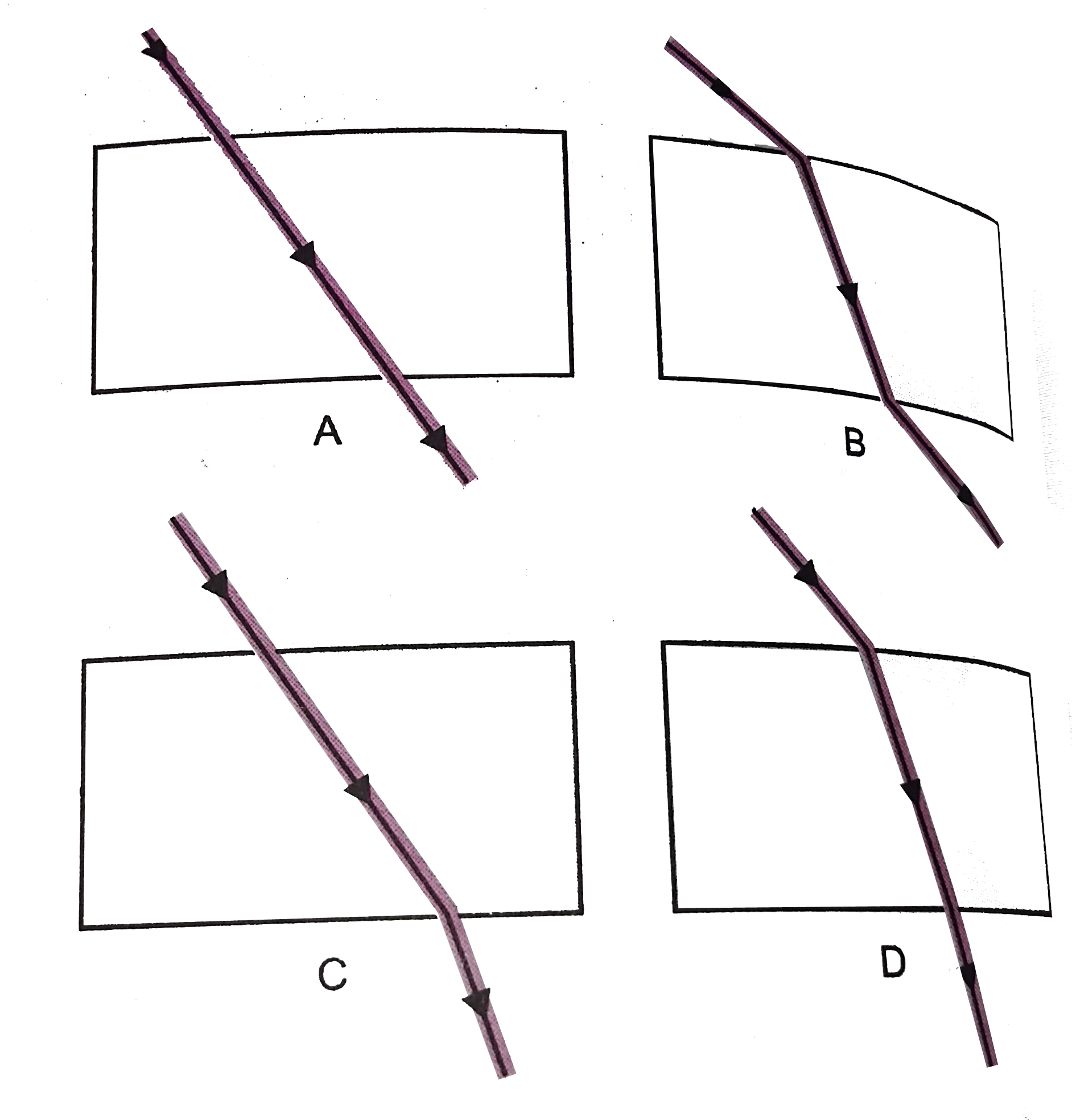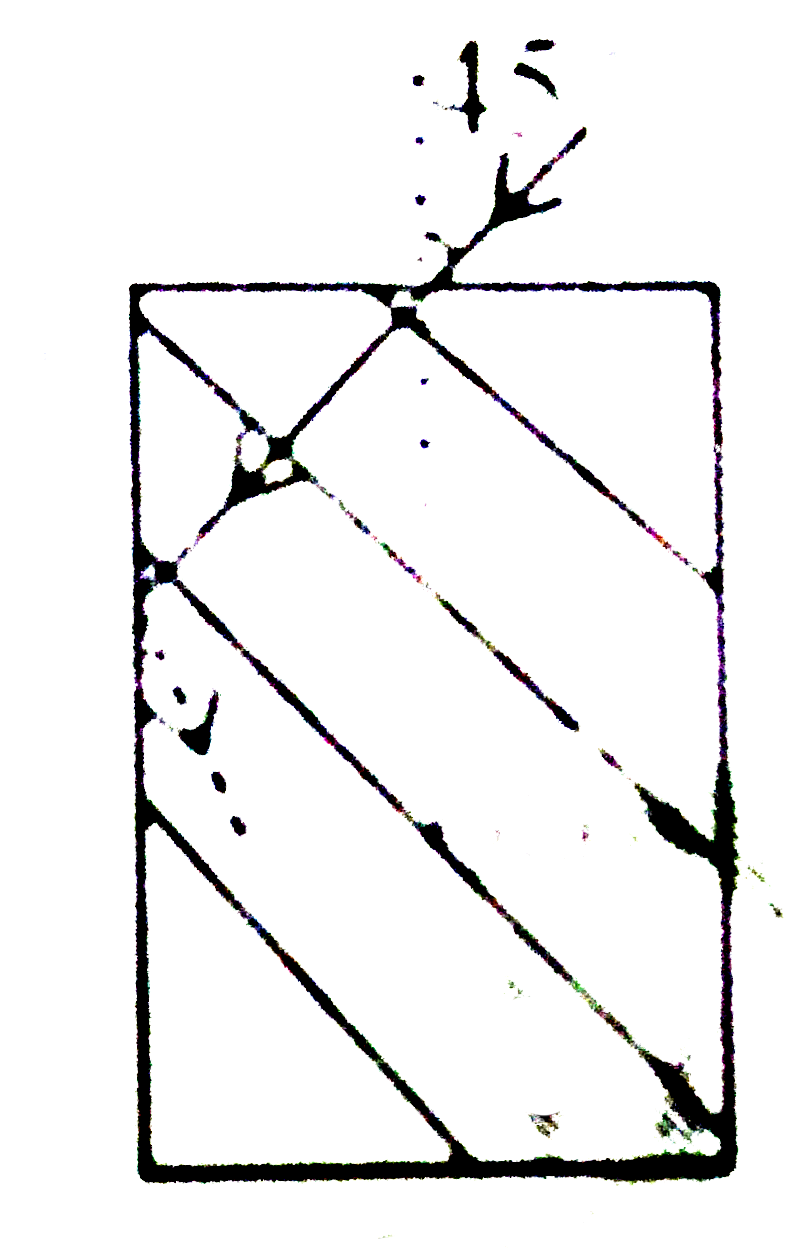Light passes through a rectangular glass slab and through a triangular glass prism. In what way does the direction of the two emergent beams differ and why?
To answer the question regarding how the direction of the emergent beams differs when light passes through a rectangular glass slab and a triangular glass prism, we can break down the explanation into clear steps:
1. Understanding the Setup:
- We have two optical elements: a rectangular glass slab and a triangular glass prism.
- Light rays will be incident on both these elements, and we need to observe the emergent rays.
2. Light Passing Through a Rectangular Glass Slab:
- When light enters a rectangular glass slab, it refracts at the first surface (air to glass) and again at the second surface (glass to air).
- The angle of incidence and the angle of refraction can be described using Snell's law.
- Importantly, because the slab is rectangular, the emergent ray will be parallel to the incident ray after passing through the slab.
3. Light Passing Through a Triangular Glass Prism:
- When light enters a triangular glass prism, it also refracts at the first surface.
- However, due to the triangular shape, the light ray bends towards the base of the prism.
- After traveling through the prism, the light refracts again at the second surface (glass to air), resulting in a change in direction.
- The emergent ray from the prism will not be parallel to the incident ray.
4. Comparison of Emergent Rays:
- In the case of the rectangular glass slab, the emergent ray is parallel to the incident ray.
- In the case of the triangular glass prism, the emergent ray is not parallel to the incident ray; it is deviated.
5. Conclusion:
- The key difference is that the emergent ray from the rectangular glass slab remains parallel to the incident ray, while the emergent ray from the triangular prism is deviated and not parallel to the incident ray.
- We have two optical elements: a rectangular glass slab and a triangular glass prism.
- Light rays will be incident on both these elements, and we need to observe the emergent rays.
- When light enters a rectangular glass slab, it refracts at the first surface (air to glass) and again at the second surface (glass to air).
- The angle of incidence and the angle of refraction can be described using Snell's law.
- Importantly, because the slab is rectangular, the emergent ray will be parallel to the incident ray after passing through the slab.
- When light enters a triangular glass prism, it also refracts at the first surface.
- However, due to the triangular shape, the light ray bends towards the base of the prism.
- After traveling through the prism, the light refracts again at the second surface (glass to air), resulting in a change in direction.
- The emergent ray from the prism will not be parallel to the incident ray.
- In the case of the rectangular glass slab, the emergent ray is parallel to the incident ray.
- In the case of the triangular glass prism, the emergent ray is not parallel to the incident ray; it is deviated.
- The key difference is that the emergent ray from the rectangular glass slab remains parallel to the incident ray, while the emergent ray from the triangular prism is deviated and not parallel to the incident ray.
Topper's Solved these Questions
Similar Questions
While traching the path of a ray of light passing through a rectangular glass slab a student tabulated his observations. If in his experiment for two readings he takes two values of ∠ians40∘and50∘ . What should be the correct values of ∠eand∠r in each case ?
View SolutionDiagram (a) and (b) in figure below show the refraction of a ray of light of single colour through a prism and a parallel sided glass slab respectively.

(i) In each diagram, label the incident, refracted, emergent rays and the angle of deviation.
(ii) In what way the direction of the emergent ray in the two cases differ with respect to the incident ray ? explain your answer.
View SolutionExplain the refraction of light through a triangular glass prism using a labelled ray diagram. Hence define the angle of diviation.
View SolutionA ray of light falls normally on a rectangular glass slab.
Draw a ray diagram showing the path of the ray till it emerges out of the slab.
View SolutionAssertion : There is no dispersion of light refracted through a rectangular glass slab.
Reason : Dispersion of light is the phenomenon of splitting of a beam of white light into its constituent colours.
View SolutionA ray of light passes through an equilateral glass prism in such a manner that the angle of incidence is equal to the angle of emergence and each of these angles is equal to 3/4 of the angle of the prism. The angle of deviation is
View SolutionThe path of a ray light coming from air passing through a rectangular glass slab traced by four students are shown as A, B, C and D in Figure. Which one of them is correct ?

View SolutionA ray of light passing through an equilateral triangular glass prism from air undergoes minimum deviation when angle of incidence is 34th of the angle of prism. Calculate speed of light in prism.
View SolutionA ray of light passing through an equilateral triangular glass prism from air undergoes minimum deviation when angle of incidence is 3/4 th of the angle of prism. Calculate the speed of light in the prism.
View SolutionA light ray falls on a rectangular glass slab as shown. The index of refraction of the glass, if total internal reflection is to occur at the vertical face, is

View Solution
